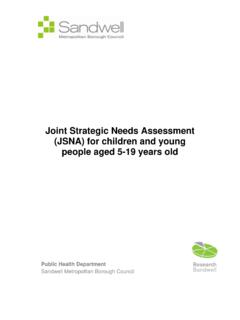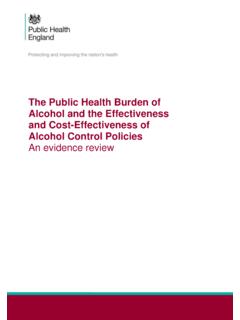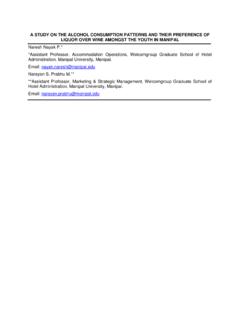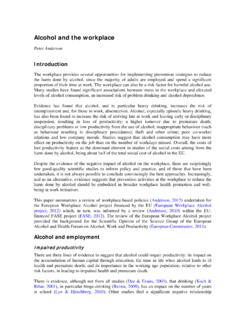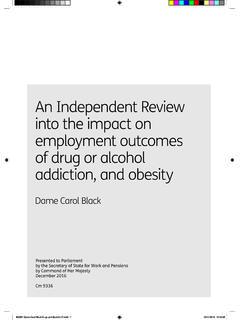Transcription of The Impact of Substance Use on the Developing Brain
1 July 2017 IMPROVING COMMUNITY HEALTH THROUGH POLICY RESEARCH 17-H07. The Impact of Substance Use on the Developing Brain Introduction Americans annually consume significant amounts SUMMARY. of alcohol, tobacco, prescription opioids, and ille- The purpose of this brief is to (a)highlight how Brain gal drugs. The National Survey of Drug Use and changes during adolescence elevate the risk for sub- Health (NSDUH) estimated that in 2014, of stance abuse and (b) describe the Impact of alcohol citizens 12 years of age or older were current- and drugs on the adolescent Brain and discuss the ly using alcohol, were using tobacco, consequences associated with these changes.
2 Were using marijuana, were using some other Substance abuse during adolescence has been tied to many negative, long-term consequences. type of illicit drug, and in the past year, had During adolescence, the Brain changes rather dra- taken prescription opioids for nonmedical pur- matically. Behaviorally, the maturation process of poses. This level of Substance use has resulted in the adolescent Brain is reflected in the greater pro- substantial economic and social consequences and pensity of adolescents to take part in risky activities represents a significant public health challenge for such as unprotected sexual activity, reckless driving, the nation [1].
3 The excessive use of alcohol alone and Substance use. cost the US $249 billion in 2010 [2], with tobacco Most peoples' first exposure to alcohol, tobacco, and costing $289 billion in 2014 [3], illicit drugs $193 other drugs typically occurs at some point during billion in 2007 [4], and prescription drugs $ adolescence. billion in 2006 [5]. Assuming spending rates re- Similar to adolescents nationally, Hoosier youths mained stable, these expenditures represent a most commonly experiment with alcohol, tobacco (primarily in the form of cigarettes and e-cigarettes), combined total of approximately $ billion and marijuana, with use of these substances increas- in 2017 dollars.
4 These estimates do not begin to ing from junior high through high school. represent the significant personal costs resulting Policy recommendations from the consequences of Substance use such as Increase prevention efforts that target adoles- addiction, loss of employment, familial disruption, cents and preadolescents. health problems, and criminal justice involvement Support legislation that limits adolescent ac- [1]. Loss of life is the most serious outcome related cess to alcohol, cigarettes, and marijuana. to Substance use; 44,827 deaths in 2015 were Increase adolescent-specific treatment ser- tied to alcohol or drug use [6], and an additional vices.
5 480,000 deaths were attributable to tobacco use Provide training to healthcare and other pro- [3]. fessionals on how Substance use can affect the With the exception of tobacco, which is Brain , how to identify signs of Substance use, used at significantly higher rates in Indiana, the and how to effectively intervene. use of alcohol, prescription pain relievers, and il- Increase prevention efforts that target pregnant licit drugs parallels the consumption levels noted women, expand services for pregnant women who for the rest of the country [1]. While the overall have Substance use problems, and reduce barriers economic cost of Hoosiers' Substance use to Indi- to accessing those services.
6 CENTER FOR. HEALTH POLICY. R I C H A R D M . FA I R B A N K S. S C H O O L O F P U B L I C H E A LT H. Indiana University Purdue University Indianapolis ana is not currently known, the state is estimated imately age 12 and lasts till somewhere between to spend over $ billion annually to address the the ages of 18 and 20, the Brain changes rather health and social consequences that stem from the dramatically. The most significant changes involve use of alcohol and tobacco [2, 7] and more than two processes: synaptic pruning and myelination. $650 million per year on healthcare costs for pre- Synaptic pruning is a process that allows the Brain scription opioid misuse [8].
7 To become more streamlined and efficient. During In order for policy makers to reduce the im- pruning, connections between neurons, or specif- pact drug use has on the state, it is important for ic types of Brain cells, that are used regularly are them to understand what factors may put Hoosiers strengthened while those which are used infre- at increased risk for escalating use and ultimately quently disappear. Structurally, the pruning pro- addiction. Brain development is one such factor. cess is reflected in a decrease in the overall volume Although ingestion of substances of abuse at any of cell bodies (gray matter) present in the Brain .
8 At age can adversely affect the Brain , there are criti- the same time that pruning is occurring, the cal periods when use can have substantially great- er Impact . One of these critical periods is adoles- Although ingestion of substances of cence. The use of substances of abuse during this phase of development has been tied to many nega- abuse at any age can adversely affect tive, long-term consequences. The purpose of this the Brain , there are critical periods brief report is to (a) highlight how Brain changes when use can have substantially during adolescence elevate the risk for Substance abuse and (b) describe the Impact of alcohol and greater Impact .
9 Drugs on the adolescent Brain and discuss the consequences associated with these changes. We long, finger-like projections that grow off of neu- believe this report will be particularly valuable to rons (axons) and allow for intercellular communi- state- and local-level legislators, persons who work cation are being coated in a fatty Substance (my- in social services agencies, prevention and treat- elin) in a process called myelination. Myelination ment professionals, and those who are interested allows neurons to communicate with each other in designing approaches that can more effectively at dramatically increased speeds.
10 From a struc- address Substance use in Indiana. tural standpoint, myelination results in steadily increasing white matter (myelin covered axons). throughout the Brain [9-12]. Pruning and myelination proceed in a very Basics of Adolescent Brain specific manner. Phylogenetically older parts of Development the Brain go through these processes sooner than From the perinatal period through childhood, the newer ones. The limbic system and the prefrontal Brain grows in size and complexity as Brain cells cortex are two areas of the Brain that are of par- (neurons) multiply, coalesce into individual struc- ticular importance during adolescence.


